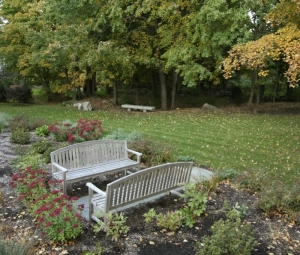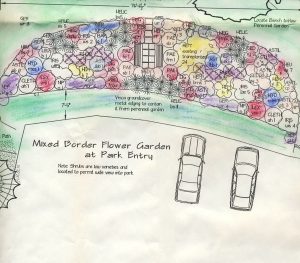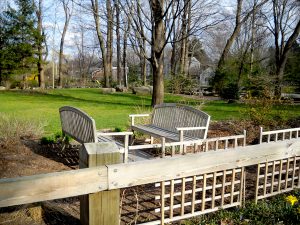Recently, I sent the link to the recent article about Carlisle Center Park I designed to a friend. His response, “Maria: That is magnificent, just magnificent!

Carlisle Center Park in fall 2008 – a secular sacred space
How gratifying it must be to see it grow into a PLACE, and a kind of secular sacred space at that, in just five years. People cherish it! Bravo, well done”.
Coincidentally, my minister asked five artists (me included as he recognizes landscape design as art) to give a short talk within the Sunday Services on the topic of “Religion and the Arts”.
Here’s the draft of my talk – Landscape Design as a Spiritual Ministry.
Most of you know I’ve been practicing Landscape Design professionally for almost 20 years, but may not know that I regard it as a spiritual ministry. (That’s because I don’t tell anyone!) Recently, a friend described the Carlisle Center Park I designed as a ‘secular sacred space’. I think he’s spot on. And I designed the place with that unspoken intention.
My design focus is beauty. I draw daily inspiration from woodland, wetland, ocean, pond, desert, mountain, and my own home gardens. I think somehow if you can know beauty in any form, then you might be transformed by it – if only for a moment – into our human better selves. And then who knows what good may happen.

My original plan for the Carlisle Center Park
Landscape design creates spaces and journeys within. The journey offers opportunities for fascination as well as the best route to your front door or the easiest way to carry in the groceries, or pick up the mail, or where friends can park their cars.
Color and form play a role offering fascination, luring us in to pause and then to perhaps to linger. It might be as Michael Pollan writes in ‘Botany of Desire’ that early humans learned to notice flowers by color so they would know where to find the sustaining fruit and vegetables later. Hardwired to appreciate flowers and thereby color, form, texture,sound, and scent, we notice. (Image: we remember a place because the red-wing black bird sings nearby the flowering blueberries shrubs where the breeze ruffles and the fragrance of lilacs drifts by.)
Researcher Rachel Kaplan’s abstract of her work, ‘The Role of Nature in the Urban Context‘, characterizes the experience of fascination in the garden as “ mini-restorative”. For most of us, fascination leads to deep breathing and relaxation and that improves our health. My take is that wonder changes our perspective at that same time .
So to me, design work is about the big picture that looks good from inside and out , solves the problems of grading and drainage, gets us directly and easily to where we need to go, and creates moments of fascination.

Carlisle Center Park in early spring 2012 – photo Marjorie Johnson, courtesy Carlisle Mosquito online paper
It’s the moments of fascination and the spaces created for them that make “a secular sacred space for spiritual restoration”. To me a landscape and garden offers possibilities of moments that ask us to pause. When we pause and let ourselves engage in fascination – perhaps by a lovely flower at our feet or a butterfly at a bloom – then we take a deep breath. And if we give ourselves permission to linger for another breath and then another – we allow all our senses into play. We relax and smile with the joy of the experience. At that moment of restoration, we are present. Present in our lives. We have taken a leap into consciousness and noticing our present moment. Nirvana for some, heaven for others, bliss for another, a ‘becoming present’ meditation practice for me.

Spring daffodils with contrasting blue vinca in carlisle Center Park. Photo Priscilla Stevens, courtesy Carlisle Mosquito
I think the sufi poet Rumi got it right when he said ”Beauty surrounds us, but usually we need to be walking in a garden to know it”. If you experience beauty in a garden, you might just see it everywhere and in every being. So with these thoughts:
May you pause and breathe in the beauty surrounding us today.
